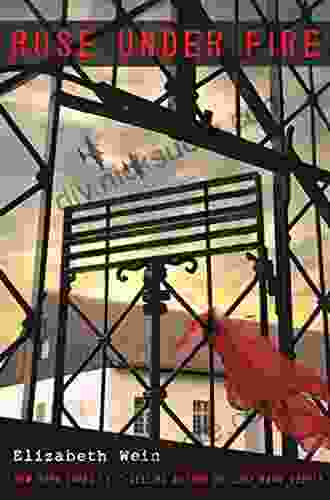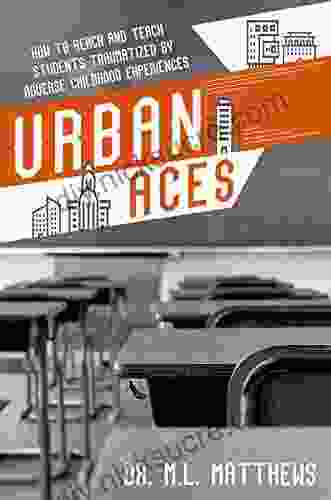How to Reach and Teach Students Traumatized by Adverse Childhood Experiences: A Comprehensive Guide

Adverse childhood experiences (ACEs) are a major public health problem. They can have a significant impact on a child's development, both in the short term and in the long term. Children who have experienced ACEs are more likely to have problems with physical health, mental health, and social development. They are also more likely to be involved in risky behaviors, such as substance abuse and violence.
The good news is that there is hope for children who have experienced ACEs. With the right support, they can overcome the challenges they face and go on to live healthy, productive lives.
This article provides a comprehensive overview of how to reach and teach students traumatized by ACEs. It includes information on the impact of ACEs on students, how to create a trauma-informed classroom, and specific strategies for teaching students with trauma.
4.7 out of 5
| Language | : | English |
| File size | : | 654 KB |
| Text-to-Speech | : | Enabled |
| Screen Reader | : | Supported |
| Enhanced typesetting | : | Enabled |
| Word Wise | : | Enabled |
| Print length | : | 86 pages |
ACEs can have a significant impact on a child's development. They can affect a child's physical health, mental health, and social development.
Physical health: Children who have experienced ACEs are more likely to have problems with physical health, such as:
- Asthma
- Obesity
- Heart disease
- Diabetes
- Cancer
Mental health: Children who have experienced ACEs are more likely to have problems with mental health, such as:
- Depression
- Anxiety
- PTSD
- Suicidal thoughts
Social development: Children who have experienced ACEs are more likely to have problems with social development, such as:
- Poor academic performance
- Difficulty forming relationships
- Aggressive behavior
The first step to reaching and teaching students traumatized by ACEs is to create a trauma-informed classroom. This means creating a safe and supportive environment where students feel comfortable learning.
Here are some tips for creating a trauma-informed classroom:
Be aware of the signs and symptoms of trauma. These can include:
- Difficulty paying attention
- Difficulty controlling emotions
- Avoiding social situations
- Aggressive behavior
- Self-harm
Be patient and understanding. Students who have experienced trauma may need more time and support than other students.
Provide opportunities for students to talk about their experiences. This can be done through individual counseling, group therapy, or journaling.
Help students to develop coping skills. These skills can help them to manage their emotions and behaviors.
Celebrate students' successes. This will help them to build confidence and self-esteem.
In addition to creating a trauma-informed classroom, there are a number of specific strategies that teachers can use to help students who have experienced trauma.
Here are some specific strategies for teaching students with trauma:
- Use a variety of teaching methods. This will help to keep students engaged and learning.
- Break down tasks into smaller steps. This will make them less overwhelming for students.
- Provide plenty of opportunities for practice. This will help students to master new skills.
- Be flexible with deadlines and expectations. Students who have experienced trauma may need more time to complete tasks.
- Offer extra support. This may include tutoring, counseling, or other services.
Teaching students who have experienced trauma can be challenging, but it is also incredibly rewarding. By creating a trauma-informed classroom and using specific strategies for teaching students with trauma, teachers can help these students to overcome the challenges they face and go on to live healthy, productive lives.
4.7 out of 5
| Language | : | English |
| File size | : | 654 KB |
| Text-to-Speech | : | Enabled |
| Screen Reader | : | Supported |
| Enhanced typesetting | : | Enabled |
| Word Wise | : | Enabled |
| Print length | : | 86 pages |
Do you want to contribute by writing guest posts on this blog?
Please contact us and send us a resume of previous articles that you have written.
 Fiction
Fiction Non Fiction
Non Fiction Romance
Romance Mystery
Mystery Thriller
Thriller SciFi
SciFi Fantasy
Fantasy Horror
Horror Biography
Biography Selfhelp
Selfhelp Business
Business History
History Classics
Classics Poetry
Poetry Childrens
Childrens Young Adult
Young Adult Educational
Educational Cooking
Cooking Travel
Travel Lifestyle
Lifestyle Spirituality
Spirituality Health
Health Fitness
Fitness Technology
Technology Science
Science Arts
Arts Crafts
Crafts DIY
DIY Gardening
Gardening Petcare
Petcare James Baldwin
James Baldwin Sean Skahan
Sean Skahan Garret Romaine
Garret Romaine Matilda Ramsay
Matilda Ramsay Kathy Koch
Kathy Koch Dame Darcy
Dame Darcy Mike Tidwell
Mike Tidwell Dave Lowry
Dave Lowry Certsquad Professional Trainers
Certsquad Professional Trainers Angela Himsel
Angela Himsel Sadie Robertson Huff
Sadie Robertson Huff Yasu
Yasu John Mordechai Gottman
John Mordechai Gottman Linda Tuhiwai Smith
Linda Tuhiwai Smith Barry Werth
Barry Werth Jack Grimshaw
Jack Grimshaw Gordon Macquarrie
Gordon Macquarrie Sandra Niche
Sandra Niche Marks Prep
Marks Prep Bill Jones
Bill Jones A L Knorr
A L Knorr Winston Starr
Winston Starr John L Parker Jr
John L Parker Jr Anne Deans
Anne Deans Bruce Lansky
Bruce Lansky Rachael Allen
Rachael Allen Barbara J Bain
Barbara J Bain Jec Aristotle Ballou
Jec Aristotle Ballou Rebecca Pelky
Rebecca Pelky Christiane Kutik
Christiane Kutik Ray Bradbury
Ray Bradbury Tripp Bowden
Tripp Bowden Karla Helbert
Karla Helbert Dr Alan Whitcomb
Dr Alan Whitcomb Susan Striker
Susan Striker Rens Bod
Rens Bod Leandro Taub
Leandro Taub Akash Kapur
Akash Kapur Rosie Garthwaite
Rosie Garthwaite Bryan Berg
Bryan Berg A J Stewart
A J Stewart Dan Limbaugh
Dan Limbaugh Calvin L Chou
Calvin L Chou Lyndall Clipstone
Lyndall Clipstone Bruce Collier
Bruce Collier Mark Ryan
Mark Ryan Jonathan Mckee
Jonathan Mckee Soap2day Publication
Soap2day Publication Toni Natalie
Toni Natalie Steve Hindman
Steve Hindman Jose M Forero Bautista
Jose M Forero Bautista Michael Lardon
Michael Lardon Rekha Ramcharan
Rekha Ramcharan Megan Vickers
Megan Vickers Chuck Whelon
Chuck Whelon Cath Smith
Cath Smith Jon Gillespie Brown
Jon Gillespie Brown Karl Knopf
Karl Knopf Dirk F Moore
Dirk F Moore Elisabeth Fassas
Elisabeth Fassas Philip Yarrow
Philip Yarrow Tim Flanagan
Tim Flanagan Joseph Mctaggart
Joseph Mctaggart Patrick Meechan
Patrick Meechan Alison Cotter
Alison Cotter Dr Howard Rankin
Dr Howard Rankin Diane Burke Fessler
Diane Burke Fessler Gabrielle Coleman
Gabrielle Coleman Bree Moore
Bree Moore John Long
John Long Marlynn Jayme Schotland
Marlynn Jayme Schotland Virginia Willis
Virginia Willis Tammara Webber
Tammara Webber Eric Armstrong
Eric Armstrong Scientia Media Group
Scientia Media Group Josh Skeen
Josh Skeen Katerina Griffith
Katerina Griffith Jim Vernes
Jim Vernes Pintip Dunn
Pintip Dunn Gemma Milne
Gemma Milne Zen Lylah
Zen Lylah Lillian Tibbles Phd
Lillian Tibbles Phd Nancy Mckenzie
Nancy Mckenzie Andrea Falk
Andrea Falk Lisa Pease
Lisa Pease Day Leitao
Day Leitao Russell Davis
Russell Davis Christine Wheeler
Christine Wheeler A F Stewart
A F Stewart Heather Gudenkauf
Heather Gudenkauf Frost Kay
Frost Kay Scott A Ostrow
Scott A Ostrow Anji Andrews
Anji Andrews Todd Rose
Todd Rose R A Mejia
R A Mejia Upton Sinclair
Upton Sinclair Jonathan S Rose
Jonathan S Rose Kathlyn Gay
Kathlyn Gay Steve Angers
Steve Angers Jan Morris
Jan Morris Chris I Naylor
Chris I Naylor Francis Pryor
Francis Pryor Raymonde Carroll
Raymonde Carroll Louis Jacques Dorais
Louis Jacques Dorais Susan Cooper
Susan Cooper Mrjamvad
Mrjamvad Nick Jackson
Nick Jackson Rebecca Black
Rebecca Black Ridge Magee
Ridge Magee Robert P Harris
Robert P Harris Dane Huckelbridge
Dane Huckelbridge Noah Gift
Noah Gift Sherrilyn Kenyon
Sherrilyn Kenyon Armin A Brott
Armin A Brott Mark Obmascik
Mark Obmascik Raymond M Smullyan
Raymond M Smullyan Thomas Mcguane
Thomas Mcguane Flo Perry
Flo Perry Cyndi Kinney
Cyndi Kinney Gary Gruber
Gary Gruber John Williams
John Williams Charles Szypszak
Charles Szypszak Steven Raichlen
Steven Raichlen Carrie Harper
Carrie Harper Anghel Leonard
Anghel Leonard Alexander Greenmaj
Alexander Greenmaj Ed Webster
Ed Webster A J Mackinnon
A J Mackinnon Sherine Hamdy
Sherine Hamdy John Brenkus
John Brenkus Peter Maas
Peter Maas Roy Richard Grinker
Roy Richard Grinker Rick Telander
Rick Telander Matt Brown
Matt Brown Roger Zelazny
Roger Zelazny Val Emmich
Val Emmich Sergey Kosarevsky
Sergey Kosarevsky Kelly Starrett
Kelly Starrett Freya Hoffmeister
Freya Hoffmeister Eva Mauer
Eva Mauer Peter Godfrey Smith
Peter Godfrey Smith Michael D Coogan
Michael D Coogan Eileen Tracy
Eileen Tracy Max Tegmark
Max Tegmark Arlin Smith
Arlin Smith David Deutsch
David Deutsch Alex Karp
Alex Karp Abigail Burd Lcsw Pmh C
Abigail Burd Lcsw Pmh C Rysa Walker
Rysa Walker Paul Mccarthy
Paul Mccarthy A G Howard
A G Howard John D Currid
John D Currid Mia Kankimaki
Mia Kankimaki Erin Watt
Erin Watt Stan Skinner
Stan Skinner Anthony J Onwuegbuzie
Anthony J Onwuegbuzie Dale P Clemens
Dale P Clemens David Remnick
David Remnick Helen E Johnson
Helen E Johnson Niall Ferguson
Niall Ferguson Michael Labossiere
Michael Labossiere N J Enfield
N J Enfield Ken Alder
Ken Alder Monte Burke
Monte Burke Iasha King
Iasha King Vitaly Pedchenko
Vitaly Pedchenko Jamie Vardy
Jamie Vardy King Solomon
King Solomon Jonalu Johnstone
Jonalu Johnstone Jm Mason
Jm Mason Stephen R Lawhead
Stephen R Lawhead Lou Tabory
Lou Tabory A H Almaas
A H Almaas A J Mackenzie
A J Mackenzie John L Messina
John L Messina Len Fisher
Len Fisher Francis Fukuyama
Francis Fukuyama Peter Shelton
Peter Shelton Laura Pohl
Laura Pohl Georgia Varozza
Georgia Varozza Lilith Mclelland
Lilith Mclelland Jennifer Trainer Thompson
Jennifer Trainer Thompson Leigh Newman
Leigh Newman Kevin Adams
Kevin Adams A M Wilson
A M Wilson Jean Philippe Dionne
Jean Philippe Dionne William Minto
William Minto A R Vasishtha
A R Vasishtha William Bauer
William Bauer Dan Romanchik Kb6nu
Dan Romanchik Kb6nu Lisa Murphy
Lisa Murphy Businessnews Publishing
Businessnews Publishing Thomas Hager
Thomas Hager Eugene Don
Eugene Don Brian Clegg
Brian Clegg David Magee
David Magee Byron Pitts
Byron Pitts Watt Key
Watt Key Sam Warburton
Sam Warburton A Roger Ekirch
A Roger Ekirch Corina Morariu
Corina Morariu Fernanda Pirie
Fernanda Pirie Peter Goldenthal
Peter Goldenthal Seth M Holmes
Seth M Holmes Thomas C Tabor
Thomas C Tabor Sharie King
Sharie King Aaron Kleinmeyer
Aaron Kleinmeyer Adrian Dater
Adrian Dater Jennifer N Smith
Jennifer N Smith A M Strickland
A M Strickland Remy Agee
Remy Agee Lyla Lee
Lyla Lee Giordano Scalzo
Giordano Scalzo Charles Butler
Charles Butler Todd Downs
Todd Downs Dr Stephanie Bloodworth Psyd
Dr Stephanie Bloodworth Psyd Dmv Test Bank
Dmv Test Bank Jamal Moustafaev
Jamal Moustafaev Cristian Salcescu
Cristian Salcescu Joe Pepitone
Joe Pepitone Din Daniels
Din Daniels Marcus Butler
Marcus Butler Ilya Ru
Ilya Ru Filippo Coarelli
Filippo Coarelli George Francis Dow
George Francis Dow Richard Heath
Richard Heath Andrew Henderson
Andrew Henderson Sky Marsen
Sky Marsen Michael Dell
Michael Dell Blair Holden
Blair Holden Helen Fitzgerald
Helen Fitzgerald Pardha S Pyla
Pardha S Pyla William Ramsey
William Ramsey Olivia Smith
Olivia Smith Peter Rees
Peter Rees John Almberg
John Almberg Paul Watzlawick
Paul Watzlawick Mitch Landrieu
Mitch Landrieu Pete Ripmaster
Pete Ripmaster Linh Phung
Linh Phung Timothy C Urdan
Timothy C Urdan Susan Aud Sonders
Susan Aud Sonders Kenay Keira
Kenay Keira Peter Nichols
Peter Nichols Emily Evans
Emily Evans Judi Garman
Judi Garman K A Riley
K A Riley Joel David Hamkins
Joel David Hamkins Harrison Fluss
Harrison Fluss Dr Tricia Groff
Dr Tricia Groff Cassandra Clare
Cassandra Clare Jennifer Senior
Jennifer Senior Tony Wright
Tony Wright Anne Sigismund Huff
Anne Sigismund Huff Matthew J Friedman
Matthew J Friedman Hazel Holmes
Hazel Holmes William C Oakes
William C Oakes Tsao Lin E Moy L Ac Msom
Tsao Lin E Moy L Ac Msom E S Wynn
E S Wynn Randy Friedman
Randy Friedman Kenneth Cloke
Kenneth Cloke Eric Blehm
Eric Blehm Tom Jordan
Tom Jordan Shelly Mazzanoble
Shelly Mazzanoble Dawn Huebner
Dawn Huebner Nicole Conway
Nicole Conway Taha Sochi
Taha Sochi Ken Castor
Ken Castor Philip Golding
Philip Golding David G Taylor
David G TaylorA G
 Katrina Abbott
Katrina Abbott Diane Stresing
Diane Stresing Joshua Akin
Joshua Akin Larit Levy
Larit Levy Sandra Swenson
Sandra Swenson Meghan Leahy
Meghan Leahy Okina Baba
Okina Baba A J Hamler
A J Hamler Helen Buckley
Helen Buckley Sarah Jo Brown
Sarah Jo Brown A L Graziadei
A L Graziadei Stan Tenen
Stan Tenen Hicham And Mohamed Ibnalkadi
Hicham And Mohamed Ibnalkadi Cailin O Connor
Cailin O Connor Cathy A Malchiodi
Cathy A Malchiodi Ray Ordorica
Ray Ordorica Jane Austen
Jane Austen Rina Kent
Rina Kent Sarah Sutton
Sarah Sutton Lauren Oliver
Lauren Oliver Lauren Muhlheim
Lauren Muhlheim Dean R Johnson
Dean R Johnson Michael Lanza
Michael Lanza Sonya Chappell
Sonya Chappell Shauna Lynn Panczyszyn
Shauna Lynn Panczyszyn Leslie Stager
Leslie Stager Jennifer L Armentrout
Jennifer L Armentrout Rebecca A Moyes
Rebecca A Moyes Lindsey Lapointe
Lindsey Lapointe Catherine Rodgers
Catherine Rodgers Micha Gorelick
Micha Gorelick Christopher Small
Christopher Small Walter Dean Myers
Walter Dean Myers Jim Allen
Jim Allen Alf Wilkinson
Alf Wilkinson Grady Hendrix
Grady Hendrix Valerio Varesi
Valerio Varesi Thomas R Martin
Thomas R Martin Shenyang Guo
Shenyang Guo Bob Trueman
Bob Trueman David Spiegelhalter
David Spiegelhalter Chris Diamond
Chris Diamond Anna Goldsworthy
Anna Goldsworthy Daniel S Pierce
Daniel S Pierce John Halligan
John Halligan Oba Ilari Aladokun
Oba Ilari Aladokun Michelle Maccarthy
Michelle Maccarthy Alyssa Padgett
Alyssa Padgett Bob Plager
Bob Plager Crystal Cestari
Crystal Cestari Cynthia Ulrich Tobias
Cynthia Ulrich Tobias Michael Shingleton
Michael Shingleton Heather Anderson
Heather Anderson A G Cairns Smith
A G Cairns Smith Harry Yoon
Harry Yoon Polly Moore
Polly Moore Bruce Tremper
Bruce Tremper Helen Marot
Helen Marot Saxton Pope
Saxton Pope Mike Branon
Mike Branon W Timothy Gallwey
W Timothy Gallwey Kenneth Cline
Kenneth Cline Ryan Gray
Ryan Gray Ari Tuckman
Ari Tuckman Chelsea Crockett
Chelsea Crockett Zen Faulkes
Zen Faulkes Lou Zambello
Lou Zambello Mj Porter
Mj Porter Kerri Hummingbird Sami
Kerri Hummingbird Sami Jordan B Peterson
Jordan B Peterson Jennie Finch
Jennie Finch Roxanne Martin
Roxanne Martin Marc S Sabatine
Marc S Sabatine Bear Heart
Bear Heart Tanya Selvaratnam
Tanya Selvaratnam The R A
The R A Mandy Rivers
Mandy Rivers A J Messenger
A J Messenger Kenn Bivins
Kenn Bivins Homeira Qaderi
Homeira Qaderi Bob Frye
Bob Frye William Scott Wilson
William Scott Wilson Lilin Yang
Lilin Yang Don Fink
Don Fink Eric Sevareid
Eric Sevareid Todd Wanerman
Todd Wanerman Brad K Chambers
Brad K Chambers Jeff Kane
Jeff Kane Russell Sher
Russell Sher William F Mann
William F Mann Matthieu Ricard
Matthieu Ricard Tiara R Brown
Tiara R Brown Todd Gitlin
Todd Gitlin David J Vanbergen Jr
David J Vanbergen Jr Caspar Craven
Caspar Craven Joe Navarro
Joe Navarro Charles Edward Chapel
Charles Edward Chapel Manoush Zomorodi
Manoush Zomorodi Boston T Party
Boston T Party Timothy J Gawne
Timothy J Gawne Ken Dryden
Ken Dryden David A Wells
David A Wells Jonathan Eig
Jonathan Eig Amos Yong
Amos Yong Catherine Stonehouse
Catherine Stonehouse Dr Kevin Leman
Dr Kevin Leman David H Barlow
David H Barlow Loretta Sponsler
Loretta Sponsler Glenn Patron
Glenn Patron A J Angulo
A J Angulo A J Carlisle
A J Carlisle Susanne Foitzik
Susanne Foitzik Lucy Christopher
Lucy Christopher Rafe Esquith
Rafe Esquith Dale Dougherty
Dale Dougherty Lindsey Vonn
Lindsey Vonn Jennifer Longmore
Jennifer Longmore Shanterra Mcbride
Shanterra Mcbride Peter Zheutlin
Peter Zheutlin Adam Savage
Adam Savage Val Mcdermid
Val Mcdermid A K Davidson
A K Davidson Amanda Ostrander
Amanda Ostrander Andreas Quast
Andreas Quast William Monk
William Monk Natalie Pompilio
Natalie Pompilio Raymond J Carroll
Raymond J Carroll Vernon Trafford
Vernon Trafford Zander Brumbaugh
Zander Brumbaugh
Light bulbAdvertise smarter! Our strategic ad space ensures maximum exposure. Reserve your spot today!
 Charlie ScottFollow ·13.8k
Charlie ScottFollow ·13.8k Ian MitchellFollow ·12.3k
Ian MitchellFollow ·12.3k Howard BlairFollow ·4.8k
Howard BlairFollow ·4.8k Deacon BellFollow ·2.8k
Deacon BellFollow ·2.8k Holden BellFollow ·6.5k
Holden BellFollow ·6.5k Robert HeinleinFollow ·2.8k
Robert HeinleinFollow ·2.8k Octavio PazFollow ·12.7k
Octavio PazFollow ·12.7k Melvin BlairFollow ·15.4k
Melvin BlairFollow ·15.4k

 Franklin Bell
Franklin BellHow Genesis Preserves Science Of Consciousness In...
The book of Genesis is...

 Ted Simmons
Ted SimmonsAt Day's Close, Night in Times Past
As the sun dips...

 Kenneth Parker
Kenneth ParkerRose Under Fire: Code Name Verity - A Heartbreaking and...
In the annals of...

 Jerry Hayes
Jerry HayesNurturing Massage for Pregnancy: A Comprehensive Guide to...
Pregnancy is...

 Blake Bell
Blake BellFill in the Blank: Word Kind of Animal Farm for Kids and...
This interactive fill-in-the-blank...
4.7 out of 5
| Language | : | English |
| File size | : | 654 KB |
| Text-to-Speech | : | Enabled |
| Screen Reader | : | Supported |
| Enhanced typesetting | : | Enabled |
| Word Wise | : | Enabled |
| Print length | : | 86 pages |














